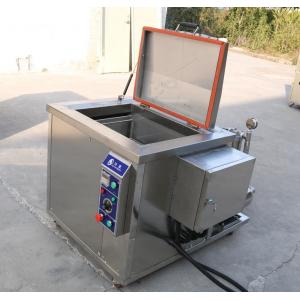28kHz 3600w 95 Gallon Ultrasonic Bath Cleaning Machine Engine Block
Parts
Application:
Ultrasonic cleaner machine is suitable for dust, oil and rust
removal, polishing . It is widely used to clean Cylinder, engine
blocks, Pistons, Manifolds, DPF-FAP filters, Turbochargers, Valve,
Marine filters, Mold etc.
Quick After -Serives
1. . Free for inquiry before purchase, relevant information is
available; 2. Free experimentation of cleaning technology;
3. Free equipment configuration;
4. Free traning for your technical and operational staff;; 5.
Equipment maintenance throughout the work
life;
6. Provide timely, efficient supply of spare parts accessories to
all user
Including
- 1 x Ultrasonic Cleaner
- 1 x Cleaning Basket
- 1 x Instruction Manual
Specifications:
| Model | JP-720G | Frequency | 40kHz or 28kHz |
| Tank capacity | 360L | Timer | digital timer regulation |
| Tank size | 1000x600x600mm 39.3''x23.6''x23.6'' | Unit size |
1170x1070x890mm
|
| wooden case | 1240*1315*1020mm | Material | SUS304/316L |
| Ultrasonic power | 2400W | N.W. | 125kg |
| Power supply | AC 100-120V,60Hz AC 220-240V, 50Hz | G.W. | 140kg |
Larger ultrasonic tanks usually feature heavier duty wall
construction and additional wall support. Heat may be supplied in a variety of ways including electric
immersion heaters, steam coils, and/or external heat exchangers. Larger tanks may have either diaphragm-bonded transducers, or
immersibles which are transducers bonded into a stainless steel can which is then mounted in the cleaning tank.
The advantages of immersibles are that a can may be swapped out if
required without the whole tank going down, and immersibles can
often be retrofitted into existing process tanks to improve
cleaning performance.
What ultraosnic can do ?
Automotive Ultrasonic Cleaners is primarily an aqueous tank
systemthat uses ultrasonic energy to remove dirt, grease, oiland
baked-on carbon from parts. Contaminants such aspaint, rust,
glued-on gaskets, and heavy layers of bake don carbon can also be
removed by ultrasonic cleaning but require more aggressive
chemistries. Unlike someother cleaning processes, ultrasonic
cleaning will notdamage intricate, lightweight, or easily damaged
parts.
Ultrasonic cleaners remove dirt, oils, lubricants, carbon, rust,and other types of grime that build up on heat exchangers.
ultrasonic cleaners can restore heat exchanger to look and function
like new.
Ultrasonic parts washers are particularly effective for metal
parts; the gentle yet powerful process is much less damaging than
traditional cleaning methods that use a brush and high-velocity
chemical cleaning solutions. Ultrasonic cleaners use water based
solutions that won’t damage filters yet reach every crack and crevice of the heat exchanger. Ultrasonic cleaning uses a process called
cavitation where microscopic bubbles form from ultrasonic waves,
then implode on the part’s components; thereby vigorously yet
gently scrubbing and cleaning surfaces and crevices. No matter how
stubborn the build-up, your heat exchanger tube will be restored to
full working capacity.
Automotive Ultrasonic Cleaner by Cavitation Action
Cavitation action is described as the implosion of countless minute
bubbles against surfaces of products immersed in the cleaning
solution. Bubbles are created when generator-powered transducers
bonded to the ultrasonic cleaner tank vibrate at ultrasonic
frequencies measured in thousands of cycles per second or kilohertz
(kHz).
Selecting the cleaning equipment is governed to a large extent by
the size of molds being cleaned. Ultrasonic cleaners are available
ranging from small benchtop units to industrial-sized floor-mounted
equipment that can be fitted for automated cleaning and rinsing
cycles. But do select a cleaner with a heater, timer and sweep
mode.
Ultrasonics: The ONLY Way to Clean with Confidence
Regardless of the source of the dirt or contamination, AG
Ultrasonic Cleaning Systems are designed to accommodate a wide
variety of uses in diverse industries. Fast, effective and
efficient, our machines will allow you to clean virtually any type
of part or component. The following is just a short list of the
many different types of items that have been cleaned using our
systems.
- Automotive (Car, Truck, Motorcycle) See Video Below
- Aviation (Helicopters, Aircraft and Ground Support)
- Personal Boat & Marine
- Injection Molds
- Restaurants, Bakeries & Kitchens (Oven Filters, Burners, Pots,
Pans, Utensils)
- Machines of All Types
- Tools, Nuts, Bolts
- Extrusion and Deburring
- Almost anything made out of metal (ferrous and non-ferrous),
plastic, vinyl, and wood.
According to your requirement, Skymen can add any optional system,
such as oil filtration, rinsing tank, drying tank and hydraulic
lifiting, throuwing. And any size is available from us.
How It Works?
This method of cleaning uses a device which produces ultrasonic
signals to clean objects that are too delicate or intricate to use
by regular means. For this process sound waves of high frequency
and a special cleaning solution are required. These sound wave
frequencies can range between 20-400 kilo-Hertz. Since it is not
easy to clean intricate or small parts this process of cleaning
eliminates the need for using any harsh chemicals.
The devices used in the process of ultrasonic cleaning are called
ultrasonic parts cleaners. Ultrasonic cleaners use special cleaning
solutions to clean grime even from the inside of cracks in the
tiniest parts. These devices are made from stainless steel and are
corrosion and rust resistant.
FAQ:
Q: What's the advantage of Skymen ultrasonic cleaner?
A: Skymen ultrasonic cleaner is the best way to have thorough
cleaning
Q: What about the warranty?
A: 1 Year warranty for Skymen ultrasonic cleaner. If any technical
problem during warranty time, replacement parts will be sent free
of charge. And technical support is also available after 1 year.
Q: What are the advantages of ultrasound over traditional cleaning
methods?
A: Minimize the use of manual labor
Make cleaning and degreasing without the use of organic solvents
Clean hard to reach areas of products and remove all types of dirt
Shorten the processes such as extraction, dispersion, purification,
chemical reactions
Eliminates costly mechanical and chemical cleaning of heat
exchangers



